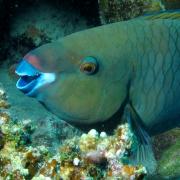Go offline with the Player FM app!
Parrotfish
Manage episode 470407232 series 1022694

The parrotfish is like a house cleaner who does a great job of keeping things tidy, but sometimes breaks a glass. You want to keep them around, but you just wish they’d be a little less destructive.
For the parrotfish, the “houses” are coral reefs. They clean tiny organisms off the coral, keeping the coral healthy. But they also chip off pieces of the coral. If they chip away too much, they can damage the coral.
Parrotfish have strong teeth. They grind up the coral they chip off, then poop it out as grains that can wash up on the beach as white sand.
The scraping can scar the hard coral—the “skeleton” created by the living organisms inside, known as polyps. In many cases, the coral heals as new polyps move in. But in others, the coral can collapse. And if too many corals are destroyed, an entire reef can suffer.
Researchers spent a decade studying the coral-parrotfish relationship in four regions of the Caribbean Sea. They looked at individual corals, complete reefs, and wider areas that encompass many reefs. They also studied the parrotfish populations.
They found that more parrotfish generally meant more damage to the corals—but not always. Parrotfish prefer some species of corals over others. So in regions where those species weren’t as common—or where there was less variety of coral species—the damage was less severe.
The results may help managers control the parrotfish catch—perhaps improving the health of coral reefs across the Caribbean.
160 episodes
Manage episode 470407232 series 1022694

The parrotfish is like a house cleaner who does a great job of keeping things tidy, but sometimes breaks a glass. You want to keep them around, but you just wish they’d be a little less destructive.
For the parrotfish, the “houses” are coral reefs. They clean tiny organisms off the coral, keeping the coral healthy. But they also chip off pieces of the coral. If they chip away too much, they can damage the coral.
Parrotfish have strong teeth. They grind up the coral they chip off, then poop it out as grains that can wash up on the beach as white sand.
The scraping can scar the hard coral—the “skeleton” created by the living organisms inside, known as polyps. In many cases, the coral heals as new polyps move in. But in others, the coral can collapse. And if too many corals are destroyed, an entire reef can suffer.
Researchers spent a decade studying the coral-parrotfish relationship in four regions of the Caribbean Sea. They looked at individual corals, complete reefs, and wider areas that encompass many reefs. They also studied the parrotfish populations.
They found that more parrotfish generally meant more damage to the corals—but not always. Parrotfish prefer some species of corals over others. So in regions where those species weren’t as common—or where there was less variety of coral species—the damage was less severe.
The results may help managers control the parrotfish catch—perhaps improving the health of coral reefs across the Caribbean.
160 episodes
All episodes
×Welcome to Player FM!
Player FM is scanning the web for high-quality podcasts for you to enjoy right now. It's the best podcast app and works on Android, iPhone, and the web. Signup to sync subscriptions across devices.



